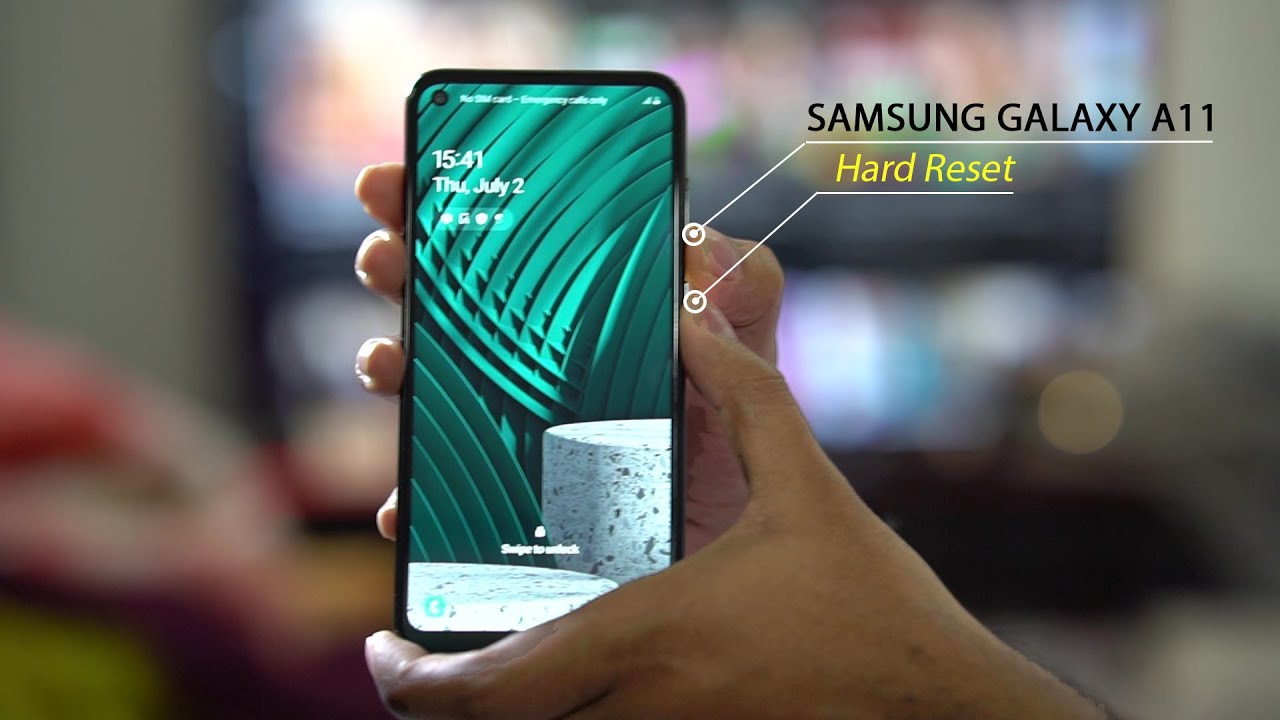Introduction
Welcome to this guide on how to factory reset your Samsung Galaxy A11. Sometimes, you may encounter issues with your device or simply want to start fresh without any data or settings. In such cases, a factory reset can be a helpful solution. It allows you to restore your smartphone to its original manufacturer settings, erasing all personal data, apps, and customization you have made.
The Samsung Galaxy A11 is a popular budget-friendly smartphone that offers a range of features and functionality. However, like any device, it may encounter software glitches, performance issues, or other problems over time. Performing a factory reset can help resolve these issues and give your device a fresh start.
It is essential to note that a factory reset will erase all data on your device, including contacts, messages, photos, videos, and apps. Therefore, it is crucial to back up any important data before proceeding with a factory reset. This guide will walk you through the steps to safely perform a factory reset on your Samsung Galaxy A11.
There are two methods you can use to factory reset your Samsung Galaxy A11: using the Settings Menu and utilizing the hardware buttons. Depending on your preference or the current state of your device, you can choose the option that works best for you.
Why would you need to factory reset your Samsung Galaxy A11?
There are several reasons why you might consider performing a factory reset on your Samsung Galaxy A11. Let’s explore some of the common scenarios where a factory reset can be beneficial:
- Device Performance Issues: Over time, your Samsung Galaxy A11 may begin to experience lag, freezes, or overall sluggish performance. This can occur due to a variety of reasons such as accumulation of temporary files, incompatible apps, or software conflicts. A factory reset can help resolve these performance issues and restore your device to its optimal state.
- Software or System Errors: If you frequently encounter error messages, app crashes, or other software-related issues, a factory reset can be a potential solution. It can help eliminate software bugs or conflicts that may be causing these errors and provide a fresh software environment for your device.
- Preparation for Selling or Donating: If you plan to sell, donate, or hand down your Samsung Galaxy A11 to someone else, performing a factory reset ensures that all your personal data and settings are securely wiped from the device. This helps protect your privacy and prevents any potential misuse of your information.
- Forgot Lock Screen Password: In cases where you forget your lock screen password or pattern, a factory reset can help you regain access to your device. However, it is important to note that performing a factory reset will erase all data on your phone, so make sure you have a backup of your important files.
- Resolving Persistent Issues after Software Updates: Sometimes, after installing a software update, you may encounter persistent issues or inconsistencies with your Samsung Galaxy A11. In such cases, a factory reset can help resolve these problems and ensure a clean installation of the updated software.
Remember, a factory reset should be approached as a last resort when other troubleshooting methods have been unsuccessful. It is essential to back up your data and consider the potential ramifications of performing a factory reset, as it will erase all data on your device. However, in many cases, a factory reset can bring improvements to your device’s performance and resolve software-related issues.
Before you factory reset your Samsung Galaxy A11
Before proceeding with a factory reset on your Samsung Galaxy A11, there are a few important steps you should take to ensure a smooth process and safeguard your data:
- Backup your data: Performing a factory reset will erase all data on your device, so it is crucial to back up any important files, contacts, messages, or media that you want to keep. You can use various methods to back up your data, such as using cloud storage services, transferring files to a computer, or utilizing Samsung’s Smart Switch app.
- Remove your Google account: To avoid any potential issues with device activation or security features after the factory reset, it is recommended to remove your Google account from your Samsung Galaxy A11. You can do this by going to the Settings menu, selecting Accounts, choosing your Google account, and tapping the Remove Account option.
- Disable Reactivation Lock: Reactivation Lock is a security feature on Samsung devices that requires your Google account credentials to activate the device after a factory reset. To ensure a smooth factory reset process, navigate to Settings, go to the Lock screen and security section, tap Find My Mobile, enter your Samsung account credentials, and disable Reactivation Lock.
- Charge your device: It is advisable to have your Samsung Galaxy A11 fully charged, or at least with a sufficient amount of battery power, before initiating a factory reset. This ensures that the process is not interrupted due to a low battery, which can potentially cause issues.
By following these preparation steps, you can minimize the risk of data loss, ensure a hassle-free factory reset, and protect your device’s security features. Once you have completed these steps, you are ready to proceed with the factory reset process.
How to factory reset your Samsung Galaxy A11
There are two methods you can use to factory reset your Samsung Galaxy A11: using the Settings Menu and utilizing the hardware buttons. Follow the steps below to perform a factory reset:
Option 1: Using the Settings Menu
- Open the Settings app on your Samsung Galaxy A11. You can access the Settings Menu by swiping down from the top of the screen and tapping the gear-shaped icon.
- Scroll down and select the “General Management” option.
- Tap on “Reset” or “Reset Options”, depending on your device’s software version.
- Choose the “Factory Data Reset” or “Factory Reset” option.
- Review the information displayed and tap on “Reset” or “Erase all data” to confirm.
- Enter any required passwords or PINs, if prompted.
- Finally, select “Delete All” or “Reset” to initiate the factory reset process.
Option 2: Using the Hardware Buttons
- Turn off your Samsung Galaxy A11 completely.
- Press and hold the Volume Up button, the Power button, and the Home button (if available) simultaneously.
- Continue holding the buttons until the Samsung logo appears on the screen. Once you see the logo, release all the buttons.
- Use the Volume Up and Volume Down buttons to navigate through the menu options, and the Power button to select “Wipe data/factory reset”.
- Confirm your selection by choosing “Yes” or “Delete all user data”.
- Wait for the reset process to complete, and then select “Reboot system now” to restart your device.
Note that the steps mentioned above may vary slightly depending on the software version of your Samsung Galaxy A11. It is always a good idea to refer to the device’s user manual or visit the official Samsung support website for additional guidance.
Once the factory reset process is complete, your Samsung Galaxy A11 will reboot into its initial setup mode. You will need to set up your device as if it were brand new, including configuring your Google account, Wi-Fi settings, and other preferences.
Option 1: Using the Settings Menu
Performing a factory reset on your Samsung Galaxy A11 using the Settings Menu is a straightforward process. Follow the steps below to reset your device:
- Open the Settings app on your Samsung Galaxy A11. You can access the Settings Menu by swiping down from the top of the screen and tapping the gear-shaped icon.
- Scroll down and select the “General Management” option. This may be labeled differently depending on the software version of your device.
- Within the General Management settings, look for the “Reset” or “Reset Options” option and tap on it. Again, the labeling may vary depending on your device’s software version.
- Choose the “Factory Data Reset” or “Factory Reset” option. This will initiate the factory reset process.
- Review the information displayed on the screen. This will inform you about the data that will be erased during the factory reset process. Take a moment to ensure you have backed up any important data.
- Tap on the “Reset” or “Erase all data” button to confirm your decision.
- If prompted, enter any required passwords or PINs to proceed with the reset process.
- Finally, select “Delete All” or “Reset” to initiate the factory reset process. This will erase all data on your device and restore it to its original factory settings.
Once the factory reset is complete, your Samsung Galaxy A11 will reboot, and you will be prompted to go through the initial setup process as if the device were brand new. You’ll need to configure your Google account, Wi-Fi settings, and other preferences.
Please note that the steps mentioned above are a general guideline, and the exact options and labels may vary slightly depending on the software version of your Samsung Galaxy A11. If you encounter any discrepancies or have trouble locating specific settings, it is recommended to consult the device’s user manual or visit the official Samsung support website for more detailed instructions.
Option 2: Using the Hardware Buttons
If you are unable to access the Settings Menu on your Samsung Galaxy A11 or experience software issues, you can use the hardware buttons to perform a factory reset. Follow the steps below to reset your device:
- Ensure that your Samsung Galaxy A11 is turned off completely.
- Press and hold the Volume Up button, the Power button, and the Home button (if available) simultaneously. Keep holding these buttons until you see the Samsung logo appear on the screen. This indicates that your device has entered recovery mode.
- Using the Volume Up and Volume Down buttons, navigate through the recovery mode menu options. Look for the option labeled “Wipe data/factory reset.”
- Once you have highlighted the “Wipe data/factory reset” option, press the Power button to select it.
- A confirmation screen will appear, asking if you want to proceed with the factory reset. Use the volume buttons to navigate to the “Yes” or “Delete all user data” option and press the Power button to confirm.
- The factory reset process will begin, and you will see a progress bar on the screen. Be patient as the device erases all data and restores the factory settings. This may take a few minutes.
- After the reset is completed, you will be returned to the recovery mode menu. Use the Volume Down button to navigate to the “Reboot system now” option and press the Power button to restart your device.
Once your Samsung Galaxy A11 reboots, it will be in its initial setup mode. Follow the on-screen instructions to configure your device, including setting up your Google account, Wi-Fi settings, and other preferences.
It is important to note that the button combinations and labels mentioned above may vary slightly depending on the hardware and software version of your Samsung Galaxy A11. If you encounter any difficulties or have trouble finding the specific options, it is recommended to consult the device’s user manual or visit the official Samsung support website for more detailed instructions.
What to do after factory resetting your Samsung Galaxy A11
After performing a factory reset on your Samsung Galaxy A11 and completing the initial device setup, there are a few essential steps you should take to ensure a smooth transition and maximize the functionality of your device:
- Restore your data: If you previously backed up your data before the factory reset, now is the time to restore it. Utilize your preferred backup method, such as Google Backup, Samsung Cloud, or a third-party app, to restore contacts, messages, photos, videos, and other important files onto your Samsung Galaxy A11.
- Reinstall apps: Visit the Google Play Store and reinstall the apps that you frequently use. You can view a list of previously installed apps in your Google Play Store account for easier installation. Take this opportunity to only install the apps you need, ensuring a clutter-free and optimized device.
- Update your device: Check for software updates to ensure your Samsung Galaxy A11 is running on the latest version of Android. Software updates often bring performance improvements, bug fixes, and security enhancements. Go to the Settings app, navigate to “Software update,” and select “Download and install” if updates are available.
- Reconfigure settings: Go through the Settings app to customize your Samsung Galaxy A11 according to your preferences. Adjust display settings, configure sound profiles, set up biometric security options, and explore additional features that enhance your user experience.
- Secure your device: Enable security features such as a lock screen PIN, password, or fingerprint recognition to protect your device and personal data. Consider enabling features like Find My Mobile to track your device if it gets lost or stolen. Additionally, consider installing a reliable antivirus application to keep your device protected from potential threats.
- Optimize device performance: Clear cache files and unnecessary data regularly to improve your device’s performance and free up storage space. You can use the built-in storage management tools or install a cache cleaner app from the Google Play Store.
By following these post-factory reset steps, you can quickly bring your Samsung Galaxy A11 back to its optimal state and ensure a seamless user experience. Remember to regularly back up your data, keep your apps and system updated, and implement security measures to keep your device functioning at its best.
Conclusion
Performing a factory reset on your Samsung Galaxy A11 can be a useful solution when you encounter software issues, performance problems, or simply want to start fresh. It allows you to restore your device to its original factory settings, erasing all personal data and settings.
In this guide, we explored two methods to factory reset your Samsung Galaxy A11: using the Settings Menu and utilizing the hardware buttons. Both methods are effective, and you can choose the one that suits your needs and preferences.
Before you proceed with a factory reset, it is essential to back up your data, remove your Google account, and disable Reactivation Lock to ensure a smooth process and protect your personal information.
After the factory reset is complete, remember to restore your backed-up data, reinstall your apps, update your device’s software, and configure your settings according to your preferences. Taking these steps will help you maximize the functionality of your Samsung Galaxy A11 and ensure a seamless user experience.
It’s worth noting that a factory reset should only be considered as a last resort when other troubleshooting methods have failed. If you are experiencing persistent issues with your device, it may be helpful to consult with Samsung support or seek assistance from a professional technician.
Remember, performing a factory reset will erase all data on your Samsung Galaxy A11. Therefore, it’s crucial to back up any important files and carefully consider the potential impact before proceeding. With proper preparation and understanding, a factory reset can be a valuable tool to resolve issues and optimize the performance of your Samsung Galaxy A11.

























